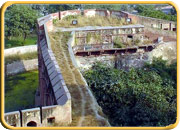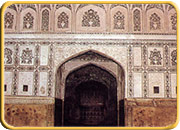Agra
Places of Interest in Agra
Agra Fort
 Golden
Pavilions
Golden
Pavilions The curved chala roofs of the small pavilions made by the Khaas Mahal are blessed on the roof shape of Bengali village huts constructed out of curved bamboo, designed to keep of heavy rains. The shape was first expressed in stone by the Sultans of bengal. Originally gilded, these were probably ladies' bedrooms with hiding places for jewelry in the walls. These pavilions are traditionally associated with Shah Jahan's daughters - Roshara and Jahanara Begum.
Khaas Mahal
Situated in between the golden pavilions is the Khaas Mahal. Built entirely of marble by Shah Jahan, the palace demonstrates distinctive Islamic-Persian features. These are well blended with a striking range of Hindu features such as chhatries. It is considered to be emperor's sleeping room or 'Aramgah'. The Khaas Mahal provides the most successful example of painting on a white marble surface.
Musamman Burj
On the left of the Khaas Mahal id the Musamman Burj built by Shah Jahan. It is a beautiful octagonal tower with an open pavilion. With its openness, elevation and the benefit of cool evening breezes blowing in off the Yamuna River, this could well have been used also as the emperor's bedroom. This is where Shah Jahan lay on his death bed, gazing at the Taj. Access to this tower is through a magnificently decorated and intimate apartment with the scalloped fountain in the centre. The inlay work here is exquisite, especially above the pillars. In front of the fountain is a sunken courtyard which could be flooded and in the Sheesh Mahal opposite are further examples of decorative water engineering in the hammams.
Sheesh Mahal
 Opposite
to the Musamman Burj and just below the Diwan-I-Khaas hall is the Sheesh Mahal
or the Glass Palace. It is believed to have been the harem dressing room and
its walls are inlaid with tiny mirrors which are the best specimens of the glass-mosaic
decoration in ndia. The Sheesh Mahal is composed of two large halls of equal
size, each measuring 11.15m X 6.40m. Both are connected in the centre by a broad
arched opening and on the sides by two narrow passages.
Opposite
to the Musamman Burj and just below the Diwan-I-Khaas hall is the Sheesh Mahal
or the Glass Palace. It is believed to have been the harem dressing room and
its walls are inlaid with tiny mirrors which are the best specimens of the glass-mosaic
decoration in ndia. The Sheesh Mahal is composed of two large halls of equal
size, each measuring 11.15m X 6.40m. Both are connected in the centre by a broad
arched opening and on the sides by two narrow passages. Diwan-i-Khaas
To the right of Sheesh Mahal is Diwan-I-Khaas, the hall of Private Audience. Presently entry is not allowed inside Diwan-I-Khaas but the fine proportions of the building can easily be appreciated. The marble pillars are inlaid with semi-precious stones in delightful floral patterns. Hammam-i-Shahi
The right of Diwan-I-Khaas is the Mammam-I-shahi or the Shah Burj. Foreign travelers who visited Agra during the reigns of Jahangir and Shah Jahan have described these apartments as the Ghasal Khana (bathroom). It was not the Turkish bathroom as is generally but erroneously supposed. It was really an "air-conditioned"apartment, attached to the residential quarters and was used as a summer retreat. Business of very confidential nature was conducted here.
Macchhi Bhawan
Opposite to the Diwan-I-Khaas is the Macchhi Bhawan, the Fish Enclosure. The emperor sat on the white marble platform facing this enclosure. It once contained pools and marble fountains which were carried off by Jat Raja Surajmal to his palace at Deeg. Around the Macchhi Bawan were the imperial offices.
Diwan-i-Am
In front of the Macchhi Bhawan is Diwan-I-Am. One can approach it by going down an internal staircase. The clever positioning of the pillars gives the visitor, arriving through the gates in the right and left hand walls of the courtyard, an uninterrupted view of the throne. On the back wall of the pavilion are jali screens to enable the women of the court to watch without being seen. The throne alcove is of richly decorated white marble. It used to house the peacock Throne. When Shah Jahan moved his capital to Delhi, it was taken to the Red Fort.
Mina Masjid
Just above the Sheesh Mahal apartments is situated the Mina Masjid which seems to have been constructed by Shah Jahan for strictly private use. The Mina Masjid is enclosed on all sides by high walls. The marble mosque has three small arches in its façade which are plain and unadorned. The most important feature in this palace-mosque is the small chhajja above the arcade which is supported on four exquisitely carved and molded, small brackets of white marble.
Nagina Masjid
From the corner opposite the Diwan-i-khaas two doorways lead to a view over the small courtyards of the zenana. Further round in the next corner is the Nagina Masjid. Shoes must be removed at the doorway. Built by Shah Jahan, this was the private mosque of the ladies of the court. Beneath it was Mina Bazaar for the ladies to make purchases from the marble balcony above.
Moti Masjid
Just above the Sheesh Mahal apartments is situated the Mina Masjid (Pearl Mosque), the most prettiest structure at Agra Fort. The building is presently closed for visitors.
Select a holiday with us